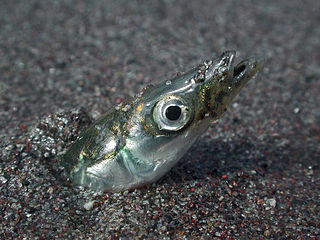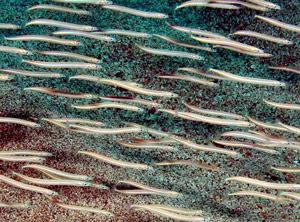
Sand eel or sandeel is the common name used for a considerable number of species of fish. While they are not true eels, they are eel-like in their appearance and can grow up to 30 cm (12 in) in length. Many species are found off the western coasts of Europe from Spain to Scotland, and in the Mediterranean and Baltic Seas.

The ribbon eel, also known as the leaf-nosed moray eel or bernis eel, is a species of moray eel, the only member of the genus Rhinomuraena. The ribbon eel is found in sand burrows and reefs in the Indo-Pacific Ocean. Although generally placed in the moray eel family Muraenidae, it has several distinctive features leading some to place it in its own family, Rhinomuraenidae.

Ophichthidae is a family of fish in the order Anguilliformes, commonly known as the snake eels. The term "Ophichthidae" comes from Greek ophis ("serpent") and ichthys ("fish"). Snake eels are also burrowing eels. They are named for their physical appearance, as they have long, cylindrical, snake-like bodies. This family is found worldwide in tropical to warm temperate waters. They inhabit a wide range of habitats, from coastal shallows and even rivers, to depths below 800 m (2,600 ft). Most species are bottom dwellers, hiding in mud or sand to capture their prey of crustaceans and small fish, but some are pelagic.

A sand lance or sandlance is a fish belonging to the family Ammodytidae. Several species of sand lances are commonly known as "sand eels", though they are not related to true eels. Another variant name is launce, and all names of the fish are references to its slender body and pointed snout. The family name means "sand burrower", which describes the sand lance's habit of burrowing into sand to avoid tidal currents.

Heteroconger is a genus of marine congrid eels. These small, slender garden eels live in groups where each individual has its own burrow. Usually, only the head and front half of the body is visible. The greatest species richness is in the Indo-Pacific, but species are also found in the warmer parts of the Atlantic and the eastern Pacific. Its name relates to how a huge colony of the eels looks swaying in the current.
The great sand eel is the greater species of sand eel. The maximum size is 35 centimetres (14 in).

Raitt's sand eel, is a small semi-pelagic ray-finned fish found in the North Atlantic Ocean. The Raitt's sand eel is member of the family Ammodytidae which includes all 31 species of sand eels, often referred to as sand lances. Contrary to their name sand eels, including Raitt's sand eel, are not true eels and instead belong to the order of “weever-like” fishes, the Trachiniformes.

Eels are ray-finned fish belonging to the order Anguilliformes, which consists of eight suborders, 20 families, 164 genera, and about 1000 species. Eels undergo considerable development from the early larval stage to the eventual adult stage and are usually predators.
Bascanichthys is a genus of eels in the snake eel family Ophichthidae. It currently contains the following species:
Ichthyapus is a genus of eels in the snake eel family Ophichthidae.
Phaenomonas is a genus of eels in the snake eel family Ophichthidae.
Yirrkala is a genus of eels in the snake eel family Ophichthidae. It is named after Yirrkala, an indigenous community in Arnhem Land, in the Northern Territory of Australia.

Ammodytes is a genus of sand lances native to the northern oceans.

Gymnammodytes is a genus of sand lances native to the eastern Atlantic Ocean, the Mediterranean Sea and the southwestern Indian Ocean along the coast of Africa.
The Oriental worm-eel, also known as the Oriental snake eel, the Oriental sand-eel or the finny sand-eel, is an eel in the family Ophichthidae. It was described by John McClelland in 1844, originally under the genus Dalophis. It is a tropical, marine and freshwater-dwelling eel which is known from the Indo-Western Pacific, including Somalia, South Africa, India, Papua New Guinea, Tahiti, French Polynesia, Indonesia, Oman, Palau, New Caledonia, the Philippines, Sri Lanka, Seychelles, and Vanuatu. It dwells at a depth range of 0 to 3 metres, and forms burrows in sand and mud sediments in estuaries, rivers, and inshore turbid waters. Males can reach a maximum total length of 36 centimetres (14 in), but more commonly reach a TL of 25 centimetres (9.8 in).
Yirrkala ori is an eel in the family Ophichthidae. It was described by John E. McCosker in 2011. It is a marine, subtropical eel which is known from South Africa, in the western Indian Ocean. It is known to dwell at a depth of 20 metres (66 ft), and inhabits substrates with coarse sand sediments. Males can reach a maximum total length of 43.8 centimetres (17.2 in), while females can reach a maximum TL of 35.3 centimetres (13.9 in).
The smooth sandeel is a species of sand eel in the family Ammodytidae.








